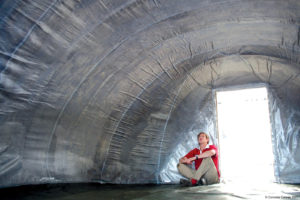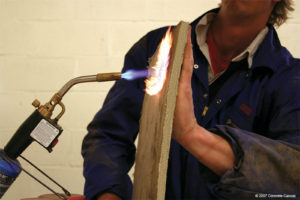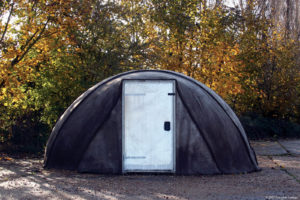A pair of young British engineers were hoping for some design competition money when they began brainstorming new uses for concrete. In the end, their innovation—Concrete Cloth—may already be saving lives.
Peter Brewin and William Crawford were studying for post-graduate degrees in London in 2004 when they started experimenting with ideas for a design competition sponsored by the British Cement Association.

“We were both quite poor at the time … and we were entering these design competitions partly because it was a good opportunity to test our ideas in front of other people and partly because it allowed us to get enough money to pay for our studies,” Brewin says.
The pair was intrigued by the compressive qualities of cement, and also by the possibility of using inflation to quickly erect a structure. The result of their experimentation: a cement-impregnated cloth that sets hard when hydrated and, when inflation is added, can form a hard shelter in 24 hours.
Concrete Cloth consists of a three-dimensional fiber matrix containing a specially formulated dry concrete mix. A PVC backing on one surface ensures that the material is waterproof, while hydrophilic fibers on the opposite surface aid hydration by drawing water into the cement.
“We had a lot of ideas for the competition, but the concrete shelter really stood out, so we thought we were onto something as an idea at that time, and then we started prototyping it, finding different ways to get the concrete cloth to work,” Brewin says. “And then, after the competition, we started looking more seriously into the application. Was there actually a use for it?”
In the field
The pair spent a month in Uganda conducting research with nongovernmental organizations and aid agencies and visiting refugee camps, seeing firsthand how vulnerable the common huts are to weather, thieves and combatants.
“That really convinced us of the applications in the aid field, where it would be very useful to have a hard building that you could get up very quickly,” Brewin says.

The shelters work this way: the cement-impregnated material is delivered folded in a sealed plastic sack (the dry weight of the 16-square-meter version is 500 kilograms, for the largest 54-square-meter version, the dry weight is 2,500 kilograms). An electric fan inflates the plastic inner layer, lifting the structure until it is self-supporting and can be anchored to the ground. The shelter is then sprayed with water, and cures into the shape of the inflation, ready for use within 24 hours.
The shelters can be covered with sand bags or earth (berming) to provide protection against small arms and shell fragments, and the hard shell and lockable doors provide a level of security not available with soft-skinned structures. The interior is sterile for medical uses, and access holes allow for the installation of water, power, air conditioning and heating units. With a design life of 10 years, the shelters provide for both immediate needs in the first days after a disaster as well as medium- to long-term operations.
“Within the humanitarian sector, we see the shelter being most useful in infrastructure applications such as medical facilities and secure storage,” Brewin says. “We have also seen a lot of interest from other areas, from mining and remote tourism camps to military applications.”
Concrete Cloth helps create protective shelters
Brewin and Crawford founded Concrete Canvas Ltd. in 2005, and have collected more than a dozen design and business awards along the way. Their facility in Wales has a production line running for the cloth and a prototype production line for the shelters. Brewin says that with the technology working, the current focus is on the details, like redesigning the door. Other challenges include experimenting with additives to the material to accelerate the set time, and in the longer term, bringing the weight down to make lighter, thinner shelters that give the same performance.

Both the shelters and the cloth are being put to the test in the extreme environment of Afghanistan, where a hard-walled shelter can mean the difference between life and death. The useable life of some soft-skinned tents in Afghanistan has been less than three weeks due to wind damage, and a U.N. coordinator for Afghanistan has noted that while starvation occurs over the course of several weeks, death from exposure can happen in a single night.
The Agency for Technical Cooperation and Development (ACTED) is using the 25-square-meter version of the shelter in its operations in Afghanistan, and Brewin believes that the agency staff will be able to provide valuable feedback about how the shelters perform and where improvements are still needed. Also in Afghanistan, the cloth is being used by the British Army to reinforce sandbag walls.
“The problem is the sandbag walls are getting a lot of incoming and outgoing fire that’s degrading the sandbags, and once they’ve been shot up … the sand leaks out and they no longer provide the protection from incoming shrapnel,” Brewin says. The Concrete Cloth holds the sand in and is also fireproof, which prevents sandbag degradation.

A demonstration in January for U.S. military and federal emergency planners was thwarted when the ship carrying the shelter was held up in customs, but the engineers were still able to give a presentation and got quite a bit of useful feedback, Brewin says. And while their initial intention for the material was in humanitarian applications, they now see a variety of potential uses, including rapid road surfacing, landing surfaces, flood defenses, spill containment and landfill lining, and roof repair and flat roof construction.
“It is immensely exciting to be at the stage where we are starting to see our technology employed in the field, and we hope that it will prove to be as useful and effective as we believe it can be,” Brewin says.
Jill C. Lafferty is a freelance writer based in Burnsville, Minn.
 TEXTILES.ORG
TEXTILES.ORG


